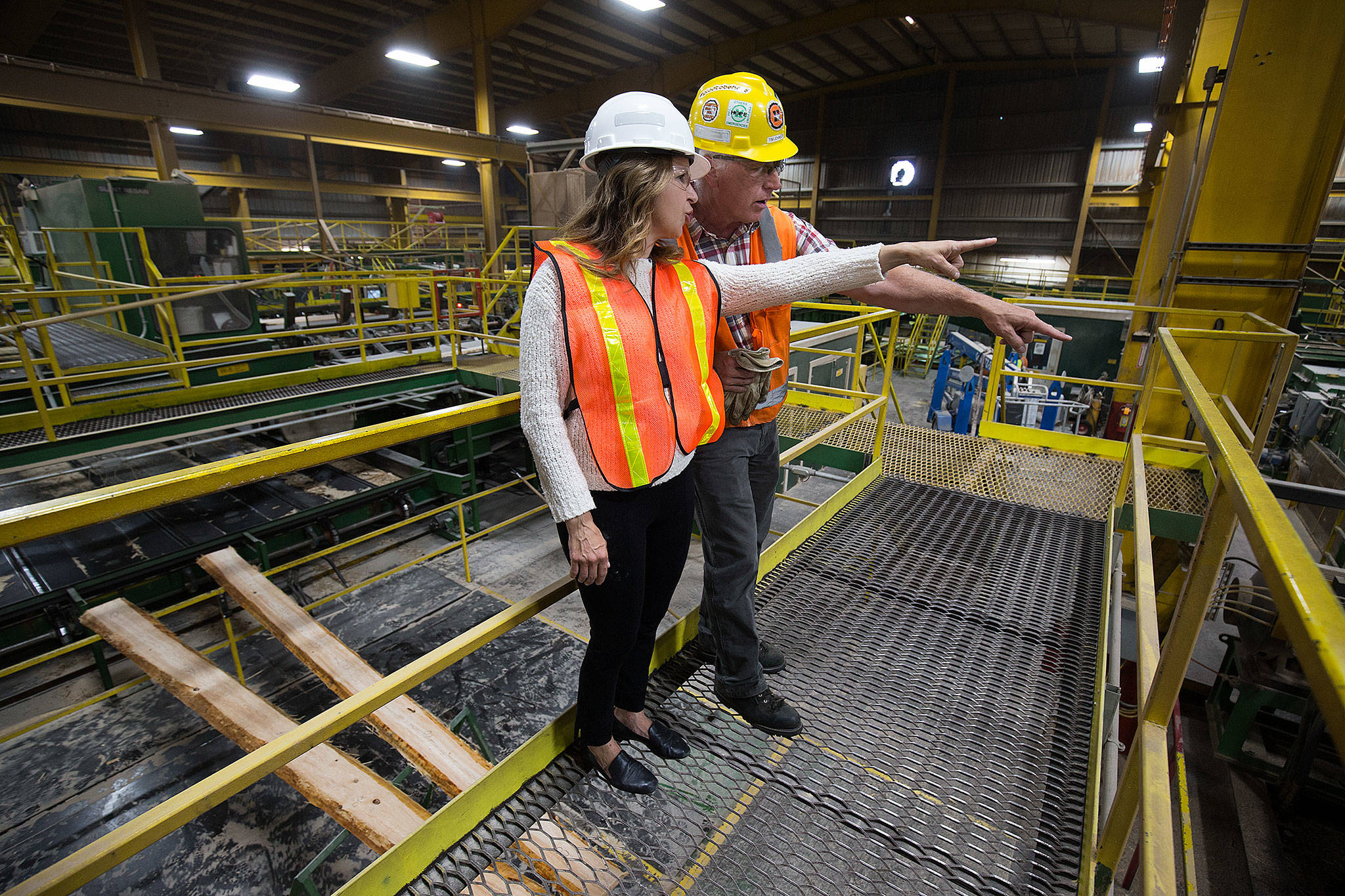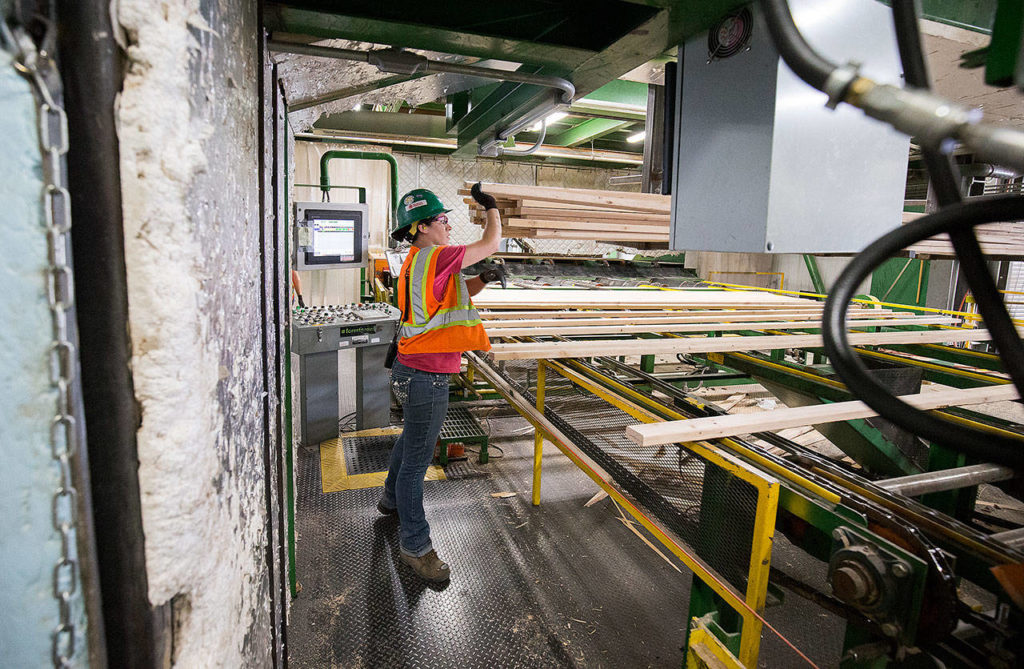DARRINGTON — In a town where the high school mascot is the Loggers, timber is embedded into the community’s identity and its way of life. But changes in state forest management will put Darrington’s largest employer, the Hampton Mill, at risk.
The mill has 175 employees, most of whom live in or near town, and it got word in December that the state Department of Natural Resources will reduce the amount of timber it can buy from state forests over the next decade.
This comes after an August meeting when mill executives told the state director of public lands Hilary Franz they’d need more logs to stay afloat.
Bad news for a rural lumber town
The mill’s log supply comes from a combination of state, federal and private timber.
The reduction in wood from state forests, coupled with a lack of timber supply from the Mount Baker-Snoqualmie National Forest, leaves the company facing a 15% reduction in product in Western Washington.
“That’s a big hit to mills and small forest sector business that run on tight margins,” mill spokesperson Kristin Rasmussen said. “It’s also a big hit to rural counties.”
In Snohomish, Skagit and Whatcom counties, which feed the Darrington mill, Rasmussen said they expect a 33% reduction from 2015 to 2024.
The Hampton mill buys about $25 million of timber from the department annually, CEO Steve Zika said. That’s more than half the mill’s logs.
It also gets a fraction from national forests, although there’s a lack of timber coming from the nearby Mount Baker-Snoqualmie National Forest. The forest sold just 10% of its assigned target in the 2019 fiscal year. That’s miles behind most federal land in Washington.
Forest Service spokesperson Colton Whitworth said the Mount Baker-Snoqualmie National Forest’s harvest numbers are low for a few reasons.
The forest is dense with rugged terrain, making access difficult and less cost-efficient, he said. There’s also lots of habitat that needs to be preserved for spotted owls and marbled murrelets.
On the east side of the state, more timber is harvested to reduce wildfire risk, which “is more of a concern in those areas,” Whitworth said.
Selective harvesting reduces the underbrush that fuels wildfires and makes it easier for managers to contain them.
Rasmussen argued Mount Baker-Snoqualmie could be vulnerable without thinning more trees.
“Large, destructive fires in the Mount Baker-Snoqualmie Forest would present a significant risk to public health and safety as well as available timber supply for nearby communities,” she wrote in an email to the Daily Herald.
With public timber supply diminishing, the Hampton Mill will have no choice but to turn to private sellers. That’s not a promising alternative. The number of private timber owners with trees the appropriate age for harvesting — 50 to 60 years old— is dwindling.
In 2019, the mill operated at 75% capacity because it didn’t have enough logs to run full-force, Zika said.
Two changes made in early December are responsible for the newest reduction in the timber coming from state land.
The timber quota for state forests is set by the Board of Natural Resources in 10-year increments known as the Sustainable Harvest Calculation.
The most recent calculation, passed on Dec. 3, covers the fiscal years 2015 to 2024. It was held up for years while the department worked on a plan to protect the marbled murrelet, a bird that nests in large conifer trees. The little seabird’s threatened status under the Endangered Species Act locked more than 175,000 acres of DNR land out of harvest while officials hammered out a strategy to preserve its habitat.
A conservation strategy for the birds, also passed Dec. 3, accounts for 1.3% of the decrease in state timber harvests in the Northwest Region, department spokesperson Kenny Ocker said.
From 2015-2019, the department harvested about 115 million board feet per year in northwest Washington, Ocker said. It expects to harvest an average of 82 million board feet per year from 2020 to 2024. Harvest levels after 2024 will be determined by a future Board of Natural Resources decision.
A hit to schools, community services, rural jobs
Funds from DNR timber sales go directly toward funding public schools as well as fire departments, libraries, hospitals and other community services.
These services will also take a hit from harvest reductions.
Statewide, they’ll see a $30 million per year cut, according to the American Forest Resource Council, a regional trade association.
In the past, the Darrington mill bought about $25 million of timber from the DNR annually, Zika said. That generated $6 million for Snohomish County schools and services per year, DNR communications director Carlo Davis said.
Without an increase in supply from the Mount Baker-Snoqualmie forest, Darrington plant manager Tim Johnson said, the mill’s future is uncertain.
Julia-Grace Sanders: 425-339-3439; jgsanders@heraldnet.com.
Talk to us
> Give us your news tips.
> Send us a letter to the editor.
> More Herald contact information.



























